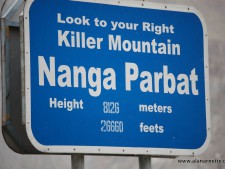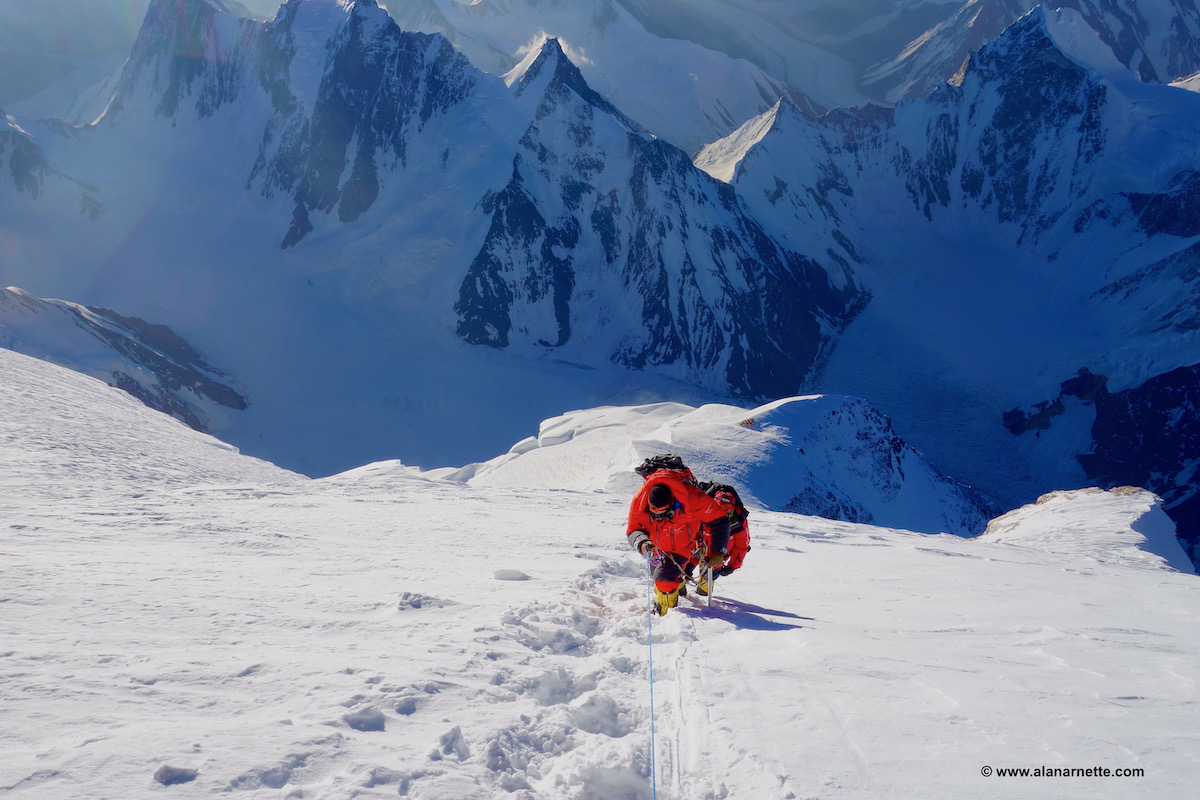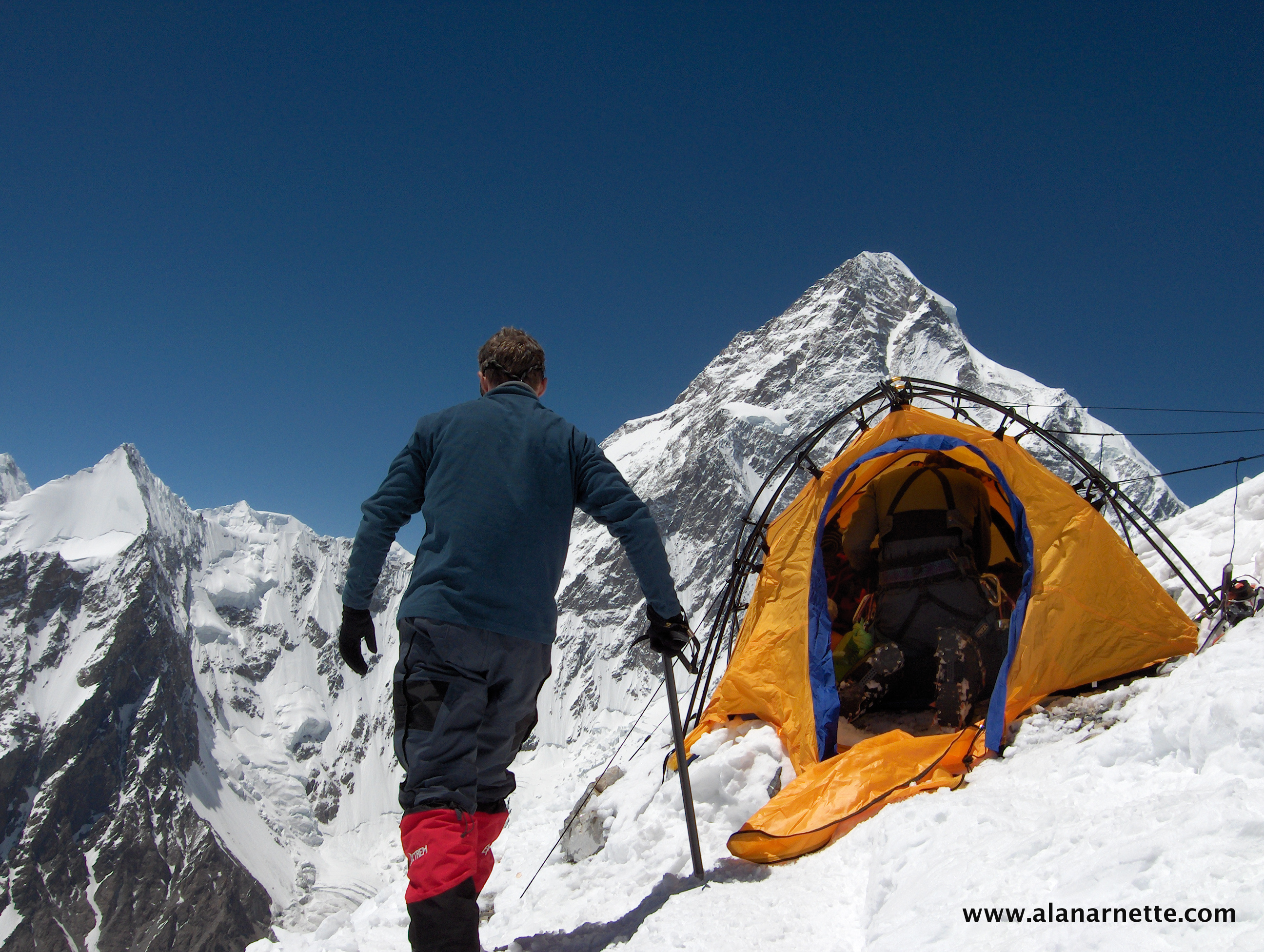It “only” took 31 attempts over 27 years but the first winter ascent of the world’s ninth highest peak, Nanga Parbat, at 8,126 meters or 26,660 feet, has finally occurred. At 3:37 pm local time February 26, 2016, three of four climbers who banded together after team after team stopped, quit or left in frustration or mystery, summited the Killer Mountain. All the climbers are now back in their Camp 4 at 7100 meters.
The team of Alex Txikon and Ali Sadpara stayed together as did Simone Moro and Tamara Lunger but they joined forces after Moro/Lunger abandoned their original plans due to dangerous serac and crevasse conditions on the Messner Route. They had reached 5800 meters on the Diamer Face.
Alex Txikon, Ali Sadpara and Daniel Nardi were the so-called International Team and set out from the beginning to climb in the traditional siege style using fixed ropes but not using supplemental oxygen on what is considered the normal route on Nanga.
In a bit of drama, Italian Daniel Nardi, apparently stormed out of base camp after Spaniard Alex Txikon shared with the world that Nardi allegedly had not paid his share of the bills for the expedition. All of this played out in a series of dueling tweets, Facebook and blog posts with the end result of Nardi leaving the team.
A long Season
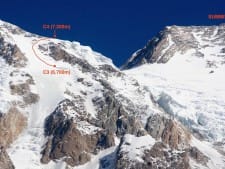 Many of the teams arrived back in December 2015 with the aim to climb quickly during the expected narrow weather windows. Some teams tried to acclimatize on other peaks, including as far away as South America, in order to attempt Nanga in alpine style, but all of these strategies proved unsuccessful as the weather had other ideas.
Many of the teams arrived back in December 2015 with the aim to climb quickly during the expected narrow weather windows. Some teams tried to acclimatize on other peaks, including as far away as South America, in order to attempt Nanga in alpine style, but all of these strategies proved unsuccessful as the weather had other ideas.
One of the reasons Nanga has proved so difficult to summit in the winter is summed up in one word: weather. And this winter proved to be no exception. There were long periods of high winds and heavy snow, plus a few serious avalanches that took out routes and camps. When a window appeared it was short and sometimes nothing close to what was predicted. So the climbers remained flexible and focused. In the end, the summit team was on the mountain for two and half months.
Summit Push
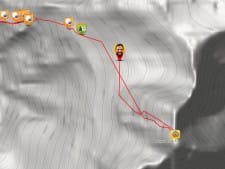 After several false starts, a window was forecasted for February 24-26 so the team jumped on it leaving base camp on February 22nd knowing they would be climbing at the end of a storm. They spent a night at Camp 2 at 6100 meters after climbing for 10 hours. But instead of moving higher, high winds that were anticipated arrived and they stayed for another night and a half.
After several false starts, a window was forecasted for February 24-26 so the team jumped on it leaving base camp on February 22nd knowing they would be climbing at the end of a storm. They spent a night at Camp 2 at 6100 meters after climbing for 10 hours. But instead of moving higher, high winds that were anticipated arrived and they stayed for another night and a half.
This effort is even more impressive as the climbers had not been able to acclimatize as they would have preferred due to weather and avalanches. Txikon and Sadpara had reached 6700m, and Moro and Lunger had touched 6100m.
Leaving their tents in the middle of the night on the 24th, they climbed to Camp 3 at 6700 meters. Finally on February 25th, they established the high point for everyone on the summit team and camped that night at 7100 meters overlooking a steep drop-off that creates the Bazhin Basin, and the route to the summit, still 1000 meters higher.
They left for the summit at 6:00 am local time on February 26. Climbing steadily all four alpinists reached the summit ridge. Tamara Lunger who was battling illness all day choose to stay on the summit ridge while the others topped out.
Alex Txikon’s base camp team received a radio call from the summit team and posted thiis on his Facebook account and blog.
3:37pm (in Pakistan). SUMMIT! We just got the confirmation by walkie: Alex Txikon, Ali Sadpara and Simone Moro have reached the top of NANGA PARBAT (8.126m) FOR THE FIRST TIME IN WINTER. Tamara Lungerstopped some meters below. Will spend night in C4 (7.200m) and tomorrow will be back in BC. Then they’ll have completed THE FIRST WINTER ASCENT OF NANGA PARBAT. Congratulations for such an excellent job!
and then on their return to 7100 meters:
Extremely tired, Alex Txikon, Ali Sadpara, Simone Moro and Tamara Lunger have already reached C4 (7.200m). Feel obviously happy and satisfyed, but admit that today’s work was “very hard and long”; that the summit-trapeze is “steeper than expected” and terrain was “really icy” on the last couloir. On the other hand, it was just extreme fatigue and early-morning-pukes what made Lunger desist not very far away from summit. Tomorrow will begin to descend at 10:00am.
Congratulations
- Ali Sadpara is first Pakistani to reach the summit of an 8000er in winter.
- Alex Txikon is first Spaniard to reach the summit of an 8000er in winter.
- Simone Moro now has 4 winter 8000 meter summits – Shisha Pangma, Makalu, Gasherbrum II and Nanga Parbat
Wrap-Up Summary
Five teams planned a winter ascent from the Diamir side and one from the Rupal side.
| Status | High Point | |
| Nanga Revolution | over | 5800m |
| International Team | summit | 8126m |
| North Face | summit | 8126m |
| Rubber Duck | over | 7500m |
| Nanga Dream | over | 7300m |
| Cleo Weidlick | over | ? |
Nanga Revolution – Kinshofer Route/Diamer Face/Alpine Style
Their plan was to climb in alpine style, but after a huge effort and a hand injury to Adam Bielecki, he and Jacek Czech ended their attempt. They had reached 5800 meters. Bielecki had an 80 foot fall where he had the injury. They first acclimatized on Ojos del Salado, 6893m, in the Andes.
International Team – Kinshofer Route/Diamer Face/Seige Style
Alex Txikon, Ali Sadpara summited and and Daniel Nardi left early. They climbed in traditional seige style using fixed ropes but not using supplemental oxygen. They summited via what is considered the normal route on Nanga.
The North Face team – Messner Route/Diamer Face/Alpine Style
Italian Simone Moro with 15 winter expeditions under his belt was attempting the Messner Route with teammate Tamara Lunger. They both summited. They had planned on acclimatizing on Spantik, 7027m, in Pakistan before heading to NB.
They teamed up with the International team after abandoning their original plans due to dangerous serac and crevasse conditions on the Messner Route where they had reached 5800 meters.
Rubber Duck Team – Messner Route/Diamer Face/Alpine Style
After reaching 7500 meters, Elisabeth Revol (France), Tomek Mackiewicz (Poland) and Arslan Ahmed Ansari (Pakistan ended their attempt. They had established their high camp and had the summit route scouted. The evening of their summit attempt, the temperature dropped to -50C and the winds were forecasted to pick up over the day or so. In the end, Mackiewicz is quoted as saying “there was no chance.” They had spent 10 days above base camp at that point. Mackiewicz has a long relationship with Nanga with attempts each winter over the past six years.
Nanga Dream, Justice for All – Schell Route/Rupal Side/Seige Style
The largest team on the mountain this season ended their attempt after reaching 7300 meters. They had nine members (seven from Poland, two Pakistani) in a traditional style with fixed ropes and camps. The Schell Route is one of the longest on Nanga and climbers usually plan on at least one bivy during their summit push. They were to have acclimatized on Rakaposhi, 7788m, in Pakistan.
Cleo Weidlich – Rupal Side
The Brazilian born US citizen arrived at base camp along with three Sherpas. It was assumed she would take the normal route. After a few weeks it was noted that two of the Sherpas left and soon thereafter, Weidlich reed as well. It’s unknown if she ever made any attempt to climb this year.
Congratulations to the Alpinists on the first winter ascent of Nanga Parbat. Next up is K2. One team has already announced a winter effort at the end of 2016.
Climb On!
Alan
Memories are Everything
NB: Thanks to the following sites for their excellent reporting on this year’s Nanga Parbat season: Altitude Pakistan, Adventure Sports, Wspinanie.pl , Desnivel

